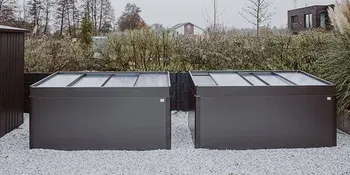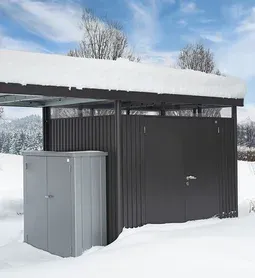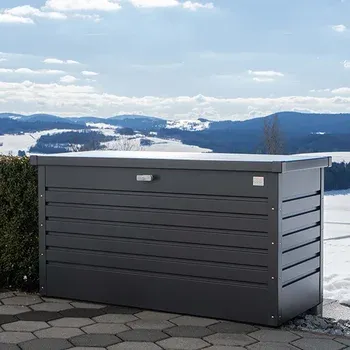The best tips for the garden in winter

Winter has arrived, but that doesn't mean that you no longer need to look after your garden. In this blog post, we give tips on choosing hardy plants, explain the importance of mulching and composting in winter and show how to properly care for shrubs and perennials during the cold season. We also offer advice on the correct storage of garden tools and how to protect plants from frost and winter storms. We give an insight into how to prick out plants in winter and why bird food not only attracts birds but also supports the ecosystem. Finally, we give an outlook on garden planning in winter, which guarantees anticipation of spring. And now let's dive into the world of winter garden care together.
Winter-hardy plants for the garden: survival artists in the cold
Mulching in winter: Natural protection and sustainable soil care
Composting in winter: The key to a fertile garden despite the cold
Effective watering in winter: How to protect your garden from frost damage
Winter care for shrubs and perennials: healthy and stronger through the cold season
Protecting plants from frost and winter storms: Tips for a robust garden
Storing garden tools safely in winter: tips for a long service life
Hardy plants for the garden: survivors in the cold
Hardy plants are plants that are resistant to the cold and can survive the cold winter without damage. They have developed adaptations to withstand cold and frost. It is advisable to use hardy plants in your own garden to keep the garden lively and colourful even in the coldest months of the year.
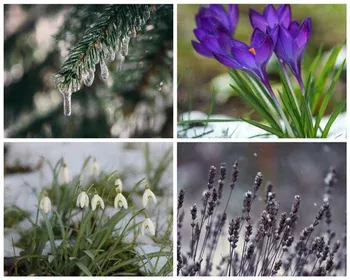
Frost-resistant plants such as winter jasmine, snowdrops and the undemanding holly not only accentuate the winter landscape, but also defy the low temperatures. When selecting plants, local climatic conditions should be taken into account to ensure optimal adaptation to local weather conditions.
Hardy plants are ideal for creating a green oasis in the garden all year round. A mix of evergreen shrubs and winter-flowering flowers not only creates particularly attractive visual appeal, but also provides shelter for birds and insects. Now it's time to choose from the variety of hardy plants and transform the garden into a winter paradise.
The specific selection of hardy plants can vary depending on the region, here is a list of easy-care and hardy plants that can thrive in many locations. It is important to clarify the specific requirements of each plant in advance to ensure that they are suitable for the climate in question.
Is a hardy and easy-care plant with bright yellow flowers. It flowers in winter and spring and is well suited for embankments or as ground cover.
Are early-flowering bulb plants that often appear in late winter. They are hardy and spread over time, bringing a charming spring aspect to the garden.
This plant is hardy and requires little care. It produces beautiful flowers in spring and striking autumn colours in autumn.
Heather is easy to care for and hardy. There are different varieties with different flower colours.
Cherry laurel is an evergreen plant that is resistant to cold and thrives even in the shade.
Stonecrops are robust plants that often take on an attractive colour in autumn. They are also drought tolerant.
Holly is an evergreen shrub with red berries that look particularly pretty in winter.
There are various types of snowballs that are hardy. They often have pretty flowers and beautiful foliage colour in autumn.
These early-flowering bulb plants are hardy and bring colour to the garden before the winter is over.
Lavender is not only hardy, but also smells wonderful. It prefers sunny locations and well-drained soil.
Native conifers (e.g. spruce, fir, pine) are generally hardy and provide structure in the garden all year round.
Peonies are hardy and flower in spring. They require little care, provided the soil is well-drained.
Like heather, Erica is an easy-care plant that thrives in acidic soils.
Mulching in winter: Natural protection and sustainable soil care
Mulching in winter is not only a simple protective shield against the winter cold, but also a sustainable method of soil care. Covering the soil with a layer of leaves, straw or bark mulch has a number of positive effects. Mulch has an insulating effect, protects the soil from extreme temperature fluctuations and protects roots from frost. Mulch also suppresses weed growth, which not only improves the appearance but also reduces the amount of maintenance required.
The organic materials decompose over time and improve the soil structure, promote water retention and support the nutrient supply. Mulching not only protects the garden bed, but also makes a sustainable contribution to the health of your own garden - a win-win situation for gardeners and nature alike.
Here are some places in the garden that are particularly suitable for mulching:
Bedding areas: This helps to retain moisture in the soil, suppress weeds and regulate the temperature.
Under trees and shrubs: Especially under dense foliage of trees or shrubs, mulching can help the soil retain moisture better, as the leaves often tend to dry out the soil.
Vegetable garden: Mulching should also be done in the vegetable garden to retain moisture, reduce weeds and stabilise the soil temperature. This is particularly important as vegetable plants often require an even moisture content in the soil.
Ornamental gardens: In ornamental gardens, where the aesthetic aspect plays a role, mulch can also be used as a decorative element. For example, bark mulch or gravel are suitable here.
Between paths and planting areas: For paths or walkways in the garden, mulching along the edges can help reduce weed spread and make the transitions look more tidy.
When mulching, it is important to use the right amount so as not to impede air circulation and to choose organic mulching materials such as straw, wood chips or bark mulch to provide nutrients to the soil as the mulch decomposes. Overall, mulching helps to create a healthy and productive environment for plants while reducing the amount of maintenance required by the gardener.
Composting in winter: The key to a fertile garden despite the cold
Even in the frosty months, composting is an essential part of sustainable gardening practices. While many think that the compost heap goes dormant in winter, this time of year provides a unique opportunity to utilise organic waste efficiently.
Winter compost not only helps to recycle kitchen waste, but also supports soil health. By adding leaves, straw and other winter garden waste, the compost heap becomes a source of heat that encourages microbiological activity. This process is not only ecologically sound, but also prepares the soil for the coming gardening season.
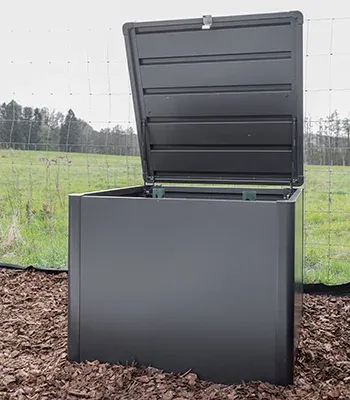
Pricking out plants in winter
Pricking out plants in winter presents a certain challenge, as the cool temperatures and low levels of sunlight affect growth. Nevertheless, pricking out is an excellent way to actively prepare for the coming gardening season, especially during the cold season. Careful pricking out makes it possible to grow strong and healthy plants that can then be optimally planted in the garden or vegetable patch in spring. It is important to consider the needs of the respective plant species and use the right technique to achieve the best possible success.
Pricking out in winter requires special care to provide the plants with optimal conditions for their development. Firstly, it is important to choose a suitable place for pricking out that offers sufficient light and warmth, for example in a conservatory or under a plant lamp. The room temperature should be kept constant to avoid abrupt temperature fluctuations. When selecting plants for pricking out, it is advisable to favour hardy varieties that are better adapted to lower temperatures.
An example of this are winter-flowering plants such as pansies or forget-me-nots. Once the seeds of these plants have been pre-germinated in a seed pot, they should be carefully separated. It is important not to damage the delicate roots and to leave enough space between the individual plants. It is advisable to allow the soil to dry slightly between watering to avoid waterlogging. This careful approach ensures that the winter-flowering plants develop robust root systems and emerge stronger for the frosty months. This lays the foundation for a successful flowering splendour that will also delight the garden in the coming spring.
The raised bed can also be used in winter, as it is possible to enjoy home-grown vegetables even in sub-zero temperatures. We reveal how to do this in this blog post.
Effective watering in winter: How to protect your garden from frost damage
Watering your garden in winter may seem counterintuitive, but it is crucial to prevent frost damage and maintain plant vitality. Before the onset of frost, make sure the soil is sufficiently watered. Well-watered soil tends to retain heat better and minimises the risk of frozen roots. However, the amount of watering should be reduced during the cold season to avoid waterlogging, which could subsequently lead to root rot. Regularly checking the soil moisture is also important in winter.
Targeted watering in line with the prevailing weather conditions ensures that the garden emerges stronger from the cold season and blossoms again in full splendour in spring. Watering in winter is therefore not only a protective mechanism, but also the key to a healthy and resilient garden.

Winter care for shrubs and perennials: healthy and strong through the cold season
Caring for shrubs and perennials in winter is crucial to ensure that the garden jewels bloom in full splendour in spring. Careful pruning not only removes dead branches, but also promotes air circulation and prevents mould growth. The frost-sensitive new shoots must be handled with care to avoid damaging them so that they have the potential to bloom next year.
Leaving dead stems on some perennials can not only serve as natural protection for overwintering insects, but also as a visual contrast in the winter garden. The winter months can be used optimally to shape the shrubs and create space for new growth. Targeted winter care not only guarantees a healthy plant life, but also ensures a splendid garden appearance as soon as spring arrives.
Protect plants from frost and winter storms: Tips for a robust garden
The frosty winter months can be a real test of endurance for our beloved plants. To ensure that your garden emerges stronger from the cold period, it is crucial to take effective protective measures. Frost-sensitive plants should be covered with breathable covering materials to protect them from frost while providing them with sufficient ventilation. Fir branches are an excellent way to provide natural protection from the cold.
Secure protection for hardy vegetables and other plants is provided by the cold frame extension from Biohort. Compatible with a raised bed size 2x1, this is an effective method of counteracting cold and frost. The four sliding double-webbed panels allow easy accessibility and at the same time provide protection at low temperatures. Although each double-webbed panel can bear a snow load of up to 25 kilograms, they should be regularly cleared of snow.
A windproof garden fleece protects against cold winds and creates a warming barrier. By following these simple but effective steps, you can ensure that your garden thrives even in adverse conditions and is in full bloom in spring.
Storing garden tools safely in winter: tips for a long service life
Storing garden tools correctly in winter is crucial to prolonging their service life and being prepared for the gardening work next spring. Tools must be thoroughly cleaned before storage and dirt and plant debris must be removed. Care must be taken to ensure that the tools are completely dry to prevent rust from forming. Ideally, the tools should be stored in a lockable tool shed or a practical tool locker. Storing them on a hook or wall bracket not only saves space, but also protects the tips of spades and rakes.
Before storing, it is advisable to lightly oil the metal surfaces to provide additional protection against corrosion. These careful measures ensure that the garden tools are optimally protected in winter and can be used without delay in spring
Further tips on the correct storage and tidy stowage of garden tools, garden tools and garden furniture in winter can be found in this blog post.
Garden planning in winter: Ideas for a blooming spring
The winter months offer the ideal time to lay the foundations for an impressive garden in the coming spring. While the temperatures drop outside, you can cosy up on the couch and start planning your garden. The winter period can be used to gather new ideas and select plants for next year. This is the best time to draw up a detailed garden plan. It is essential to consider the advantages and disadvantages of the different locations; important aspects include sunlight and soil conditions.
The winter months are also ideal for making structural changes or creating new beds. You should choose plant combinations that are not only visually appealing, but also take into account care and water requirements. By starting garden planning in winter, you can lay the foundations in good time for a lush, colourful garden that will be in full bloom in spring.
In winter, you can also think about whether you are satisfied with the storage options in your own garden, whether everything is practically and neatly organised and therefore easy to use. You can easily discover the numerous Biohort storage options such as garden shedsand garden boxes online and find the right and durable storage solution for you. In this blog post, we reveal how to make the most of the storage space in the shed.
Feeding birds in winter: Helping feathered friends in the cold
The winter months can be challenging for birds when natural food sources become scarce. Feeding birds in winter not only offers you the opportunity to enjoy the beauty of your visitors, but is also an important help for our feathered friends. It is best to put out a bird feeder with different types of food to ensure a varied diet. Seed mixes, tit dumplings, oatmeal and nuts are popular treats. Care should be taken to ensure that the feeders are regularly topped up and cleaned to prevent the spread of disease. Bird feeding not only creates a winter idyll in the garden, but also makes an important contribution to nature conservation by providing birds with a reliable source of food during the cold season.
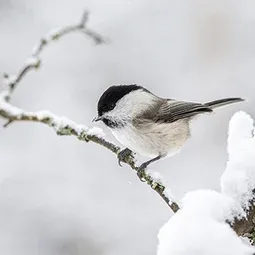
With these simple gardening tips, your own garden will not only survive the winter well, but will also bring joy to your life during the cold season. The right care in winter lays the foundation for a blossoming garden in spring. We hope you enjoy caring for your garden in winter and preparing it for next spring.
